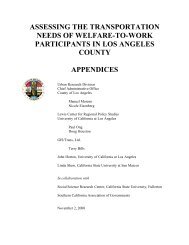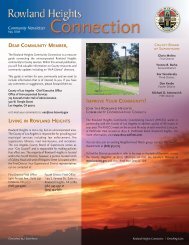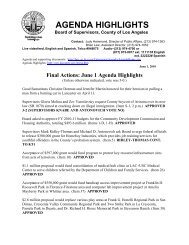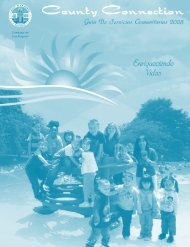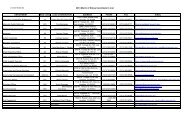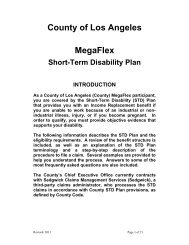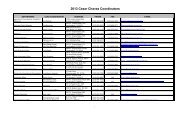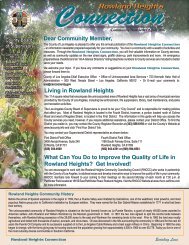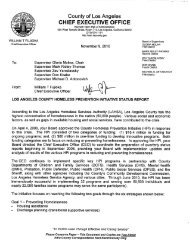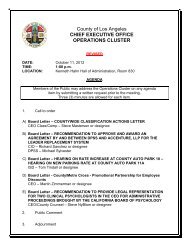Annual Report - Chief Executive Office - Los Angeles County
Annual Report - Chief Executive Office - Los Angeles County
Annual Report - Chief Executive Office - Los Angeles County
Create successful ePaper yourself
Turn your PDF publications into a flip-book with our unique Google optimized e-Paper software.
The area comprising present-day <strong>Los</strong> <strong>Angeles</strong> <strong>County</strong> was<br />
first explored by Europeans in 1769 when Gaspar de<br />
Portola and a group of missionaries camped on what is now<br />
the banks of the <strong>Los</strong> <strong>Angeles</strong> River. A member of the party, Friar<br />
Juan Crespi, suggested the area be named “Nuestra Senora de<br />
<strong>Los</strong> <strong>Angeles</strong> de la Porciuncula” (Our Lady the Queen of the<br />
Angels of Porciuncula).<br />
In September 1771, Father Junipero Serra and a group of<br />
Spaniards founded the San Gabriel Mission as the center of the<br />
first "community" in an area inhabited by small bands of Gabrielino<br />
Indians. Ten years later the Pobladores, a group of 11 families<br />
recruited from Mexico by Capt. Rivera y Moncada, traveled from<br />
the San Gabriel Mission to a spot selected by Alta California Gov.<br />
Felipe de Neve to establish a new pueblo. The settlement was<br />
named El Pueblo de la Reyna de <strong>Los</strong> <strong>Angeles</strong> (The Pueblo of the<br />
Queen of the Angels). In its early years, the town was a small,<br />
isolated cluster of adobe-brick houses and random streets carved<br />
out of the desert, and its main product was grain. Over time, the<br />
area became known as the Ciudad de <strong>Los</strong> <strong>Angeles</strong>, "City of<br />
Angels."<br />
In September 1797, the Franciscan monks established the San<br />
Fernando Mission Rey de Espana in the northern San Fernando<br />
Valley.<br />
Although the Spanish government placed a ban on trading with<br />
foreign ships, American vessels began arriving in the early 1800s,<br />
and the first English-speaking inhabitant settled in the area in 1818.<br />
He was a carpenter named Joseph Chapman, who helped build the<br />
church facing the town's central plaza, a structure that still stands.<br />
California was ruled by Spain until 1822, when Mexico assumed<br />
jurisdiction. As a result, trade with the United States became more<br />
frequent. The ocean waters off the coast of California were<br />
important for whaling and seal hunting, and a number of trading<br />
ships docked at nearby San Pedro to buy cattle hides and tallow. By<br />
the 1840s, <strong>Los</strong> <strong>Angeles</strong> was the largest town in Southern<br />
California.<br />
After a two-year period of hostilities with Mexico beginning in 1846,<br />
the area came under U.S. control. The Treaty of Cahuenga, signed<br />
in 1847, ended the war in California, followed by the Treaty of<br />
Guadalupe Hidalgo in 1848 adding <strong>Los</strong> <strong>Angeles</strong> and the rest of<br />
California to American territory.<br />
Gold Rush and Growth<br />
The annexation of California and the discovery of gold brought<br />
adventurers and immigrants alike by the thousands to the West with<br />
dreams of “hitting pay dirt.” Contrary to popular belief, California's<br />
Gold Rush began in the hills southwest of the Antelope Valley in<br />
1842, when Francisco Lopez, stopping for lunch while searching for<br />
stray cattle, pulled some wild onions and found flakes of gold<br />
clinging to their roots. The canyon was named Placeritas, meaning<br />
14<br />
History of <strong>Los</strong> <strong>Angeles</strong> <strong>County</strong><br />
<strong>County</strong> of <strong>Los</strong> <strong>Angeles</strong> <strong>Annual</strong> <strong>Report</strong> 2006-2007<br />
"Little Placers," and today is called Placerita Canyon. Gold rushers<br />
soon flocked to the canyon and took an estimated $100,000 of gold<br />
from the region before heading north to the more exciting and wellknown<br />
discovery at Sutter's Mill in 1848. A subsequent gold strike<br />
in the mountains to the north of <strong>Los</strong> <strong>Angeles</strong> provided the town with<br />
a booming market for its beef, and many prospectors settled in the<br />
area after the Gold Rush. Mining changed the region's history in<br />
profound ways, as gold seekers settled permanently in the Antelope<br />
Valley during the 1850s and 1860s. The area further grew during<br />
the Civil War (1860-1865), as gold, silver, and copper were<br />
extracted from the Soledad Canyon region and Fremont's Pass was<br />
enlarged to facilitate and speed up ore shipments.<br />
After the Civil War ended, there was a large immigration into the<br />
<strong>Los</strong> <strong>Angeles</strong> area. Several large Mexican ranches were divided into<br />
many small farms, and such places as Compton, Downey, Norwalk,<br />
San Fernando, Santa Monica and Pasadena sprang into existence.<br />
During its history, the size of the <strong>County</strong> has changed substantially.<br />
Originally it was 4,340 square miles along the coast between Santa<br />
Barbara and San Diego, but grew to 34,520 square miles, sprawling<br />
east to the Colorado River. Today, with 4,084 square miles, it is<br />
slightly smaller than its original size. The <strong>County</strong> was divided up<br />
three times: Kern <strong>County</strong> received a large slice in 1851; San<br />
Bernardino <strong>County</strong> split off in 1853; and Orange <strong>County</strong> was<br />
established in 1889.<br />
Incorporation<br />
On Feb. 18, 1850, the <strong>County</strong> of <strong>Los</strong> <strong>Angeles</strong> was established as<br />
one of the 27 original counties, several months before California<br />
was admitted to the Union. The people of <strong>Los</strong> <strong>Angeles</strong> <strong>County</strong> on<br />
April 1, 1850 asserted their newly won right of self-government and<br />
elected a three-man Court of Sessions as their first governing body.<br />
A total of 377 votes were cast in this election. In 1852 the<br />
Legislature dissolved the Court of Sessions and created a fivemember<br />
Board of Supervisors. In 1913 the citizens of <strong>Los</strong> <strong>Angeles</strong><br />
<strong>County</strong> approved a charter recommended by a board of freeholders<br />
which gave the <strong>County</strong> greater freedom to govern itself within the<br />
framework of state law.<br />
Soon thereafter <strong>Los</strong> <strong>Angeles</strong>, which had been designated as the<br />
official “seat” of <strong>County</strong> government, was incorporated as a city. It<br />
had a reputation as one of the toughest towns in the West. "A<br />
murder a day" only slightly exaggerated the town's crime problems,<br />
and suspected criminals were often hanged by vigilante groups.<br />
Lawlessness reached a peak in 1871, when, after a Chinese<br />
immigrant accidentally killed a white man, an angry mob stormed<br />
into the Chinatown district, murdering 16 people. After that, civic<br />
leaders and concerned citizens began a successful campaign to<br />
bring law and order to the town.<br />
Immigrants



